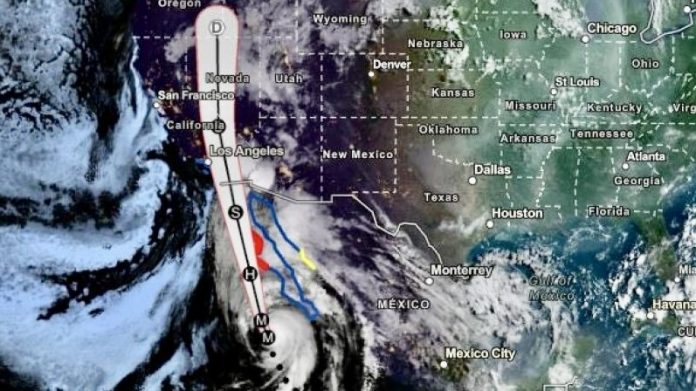
Los Angeles, Aug. 20, 2023 (UPI) — Millions of residents of the southwestern United States prepared for potentially “life threatening” flooding and storms early Sunday as Hurricane Hilary neared landfall on Mexico’s Baja California peninsula.
Hilary on Saturday was downgraded from a Category 2 to Category 1 storm but still is expected to pack “catastrophic and life-threatening flooding” while moving over Baja California and the southwestern United States through Monday, according to a National Weather Service update issued at 8 a.m. EDT.
The hurricane was located over the Pacific Ocean a few miles west of the peninsula, moving toward the north-northwest at about 21 mph. Forecasters said it is expected to accelerate along its path during the day, making landfall first on the peninsula’s west-central coast on Sunday morning and then moving across southern California in the afternoon.
Hilary was packing maximum sustained winds of near 80 mph with higher gusts.
The storm is likely to still be a hurricane while it passes over central Baja California but is expected to weaken to a tropical storm before it reaches southern California. Flood watches are in effect from southern California through Arizona, extending north to Oregon and Idaho.
California Gov. Gavin Newsom declared a state of emergency for much of southern California late Saturday as forecasters called for rainfall amounts of 3 to 6 inches, with isolated amounts of 10 inches, across portions of southern California and southern Nevada — levels deemed to be “dangerous to catastrophic.”
It would mark the first tropical storm to officially made landfall in California since record-keeping began in 1949.
Newsom proclaimed the emergency in San Diego while visiting with California National Guard troops. He also met with first responders and local officials, including San Diego Mayor Todd Gloria, and indicated he has been in touch with federal officials, including the White House.
There are currently more than 7,500 “boots on the ground” deployed to help local communities from the impacts of Hurricane Hilary, he said.
“California has thousands of people on the ground working hand-in-hand with federal and local personnel to support communities in Hurricane Hilary’s path with resources, equipment and expertise,” Newsom said. “We’re mobilizing all of government as we prepare and respond to this unprecedented storm.”
The U.S. Navy on Saturday started moving some of its ships out to sea to avoid being damaged in port at Naval Base San Diego. The nuclear-powered USS Nimitz aircraft carrier was the first to leave Saturday morning.
In Arizona, the areas considered at risk for “excessive rain” was increased on Saturday as NWS forecasters placed the city of Phoenix in a “marginal risk” category of 5%.
Arizona Gov. Katie Hobbs is keeping tabs on Hurricane Hilary and has met with Federal Emergency Management Agency and U.S. Customs and Border Protection officials to prepare for the storm, her office told the Arizona Republic.
And in Nevada, forecasters issued a flood advisory for much of the Las Vegas area running through Monday afternoon, warning that excessive storm runoff could cause flash flooding in many areas, especially in the western Mojave desert.
The coming of Hurricane Hilary has cooled off the U.S. Southwest, which for much of the summer has been baking under weeks of record high temperatures. The high in Las Vegas on Saturday was 79. the lowest high ever for Aug. 19.





